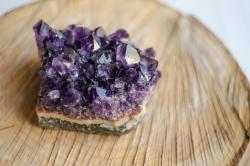
In ancient times, amethysts, with their wide array of regal purple hues, were known as the “Gem of Fire.” At times in history, this semi-precious stone has been worth as much as a diamond. Amethysts, with colors ranging from light mauve to a deep violet purple, are also recognized as the stone of St. Valentine and an enduring symbol of faithful love.
If you’re looking for a meaningful gift for that someone special, a beautiful amethyst – the symbol of love – is a sure way to make a statement.
Value for amethysts depends almost entirely on color – and the variety of color has increased the stone’s global popularity. The artistry of gemstone faceting can shine through these gems if given fancy and unusual cuts, and there is a current upswing as more people are choosing colored gemstones as a vibrant alternative to diamonds.
Amethyst is a member of the mineral quartz family, the second most abundant material found in the Earth’s crust. It is the most expensive variety of quartz, which is frequently found inside of geodes. Amethysts can be found all over the world, with the majority being mined from volcanic rock in Africa, Brazil and Uruguay. It can also be found in parts of Zambia, Mexico, Italy, Germany, Canada, Austria, Russia, South Korea, Sri Lanka and even right here in the United States!
Purple amethysts have been highly esteemed throughout history for their stunning beauty and legendary powers to stimulate and soothe the mind and emotions. This “Gem of Fire” carries the energy of fire and passion, creativity and spirituality, yet bears the logic of temperance and sobriety. This gemstone has been worn by royalty throughout the ages and was once revered as the “Jewel of the Gods.”
A Symbol of Love and “All-Healer”
Amethysts are also recognized as the stone of St. Valentine and symbol of faithful love.
In the Middle Ages, if a heart-shaped amethyst set in silver was given by a wife to her husband, it was thought to bring the newlyweds happiness and peace for the remainder of their lives.
Besides the beauty of the amethyst, in ancient times, the stone was believed to be effective in curing a range of health problems including migraines, arthritis, insomnia, withdrawal symptoms, stress and nervous tension, paranoia, schizophrenia, and poor blood circulation. It was also believed to boost the production of hormones to optimum performance.
The name amethyst is derived from the Greek word amethystos which translated means “remedy against drunkenness.” It was believed that drinking alcohol from a goblet or bowl made entirely of amethyst would allow a person to drink without becoming intoxicated.
Modern medical professionals considering the health properties of amethysts may not find evidence to support the beliefs held by people centuries ago, but the historical importance of amethysts adds to their allure for collectors today.
How to Protect
If possible, try to avoid wearing natural amethyst stones in sunlight. These stones are sensitive and their color fades in direct sunlight or when put near heat. Amethyst is easy to care for. To clean, use warm soapy water and a soft cloth.
The beauty of amethyst, and the deep and evocative history of amethyst only adds to the beauty of this symbol of love.
Kristi Cowan, AJP (GIA), is a senior risk consultant at Chubb Personal Services.
The opinions and positions expressed are the authors’ own and not those of Chubb. The information and/ or data provided herein is for informational purposes only and is not a substitute for professional advice. Insurance coverage is subject to the language of the policies as issued.